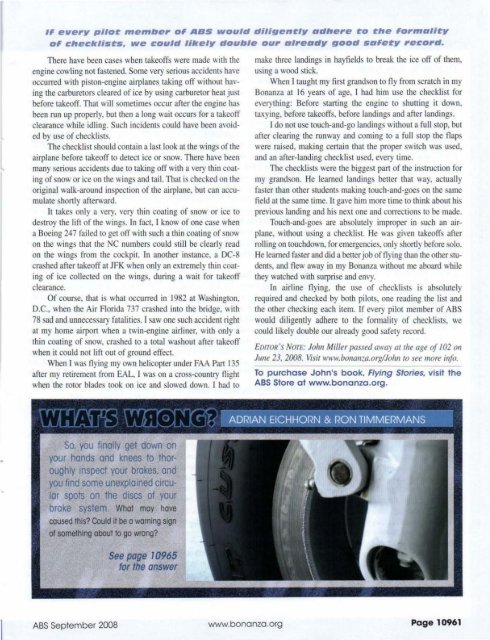1 ~\ J\ G J\ Z I I I r' - American Bonanza Society
1 ~\ J\ G J\ Z I I I r' - American Bonanza Society
1 ~\ J\ G J\ Z I I I r' - American Bonanza Society
- No tags were found...
Create successful ePaper yourself
Turn your PDF publications into a flip-book with our unique Google optimized e-Paper software.
IF elrer" pilot Iftelftber of ASS would diligentl" adhere to the Forlftallt"of checklists, we could IIkel" double our alread" good saFet" record.There have been cases when takeoffs were made with theengine cowling not fastened. Some very serious accidents haveoccurred with piston-engine airplanes taking off wi thout havingthe carburetors cleared of ice by using carburetor heat justbefore takeoff. That will sometimes occur after the engine hasbeen run up properly, but then a long wait occurs for a takeoffclearance while idling. Such incidents could have been avoidedby use of checklists.The checklist should contain a last look at the wings of theairplane before takeoff to detect ice or snow. There have beenmany serious accidents due to taking off with a very thin coatingof snow or ice on the wings and tai l. That is checked on theorigi nal walk-around inspection of the aiIplane, but can accumulateshonly afterward.It takes only a very, very thin coating of snow or ice todestroy the lift of the wings. In fact, I know of one case whena Boeing 247 failed to get off with such a thin coating of snowon the wings that the NC numbers could still be clearly readon the wings from the cockpit. In another instance, a DC-8crashed after takeoff at JFK when only an extremely thin coatingof ice collected on the wings, during a wait for takeoffclearance.Of course, that is what occurred in 1982 at WaShington,D.C., when the Air Florida 737 crashed into the bridge, with78 sad and unnecessary fatali ties. I saw one such accident rightat my home airpon when a twin-engine airliner, with only athin coating of snow, crashed to a total washout after takeoffwhen it could not lift out of ground effect.When I was flying my own helicopter under FAA Pan 135after my retirement from EAL, I was on a cross-country flightwhen the rotor blades took on ice and slowed down. [ had tomake three landings in hayfields to break the ice off of them,using a wood stick.When I taught my first grandson to fly from scratch in my<strong>Bonanza</strong> at 16 years of age, I had him use the checklist foreverything: Before staning the engine to shutting it down,taxying. before takeoffs, before landings and after landings.I do not use touch-and-go landings wi thout a full stop, butafter clearing the runway and coming to a full stop the fl apswere raised, making cenain that the proper switch was used,and an after-landing check list used, every time.The checklists were the biggest pan of the instruction formy grandson. He learned landings beller that way, actuallyfaster than other students making touch-and-goes on the samefield at the same time. It gave him more time to think about hisprevious landing and his next one and corrections to be made.Touch-and-goes are absolutely improper in such an airplane,without using a checklist. He was given takeoffs afterrolling on touchdown, for emergencies, only shonly before solo.He learned faster and did a beller job of flying than the other students,and flew away in my <strong>Bonanza</strong> without me aboard whilethey watched with surprise and envy.In airline flying, the use of checklists is absolutelyrequired and checked by both pilots, one read ing the list andthe other checking each item. If every pilot member of ABSwould diligently adhere to the formality of checklists, wecou ld likely double our already good safety record.EDITOR'S NOTE: Johll Miller passed away ollhe age of 102 allJlllle 23, 2008. VisillVlVlv.bollollzo.orgIJohll to see 1Il0re illfo.To purchase John's book, Flying Stories, visit theABS Store at www.bonanza.org.-- . - --- ---, ADRIAN EICHHORN & RON TIMMERMANSSo, you finally get down onyaur hands and knees to thoroughlyinspect your brakes, andyou find some unexplained circularspots on the discs of yourbrake system. What may havecaused this? Could it be a warning signof something about to go wrong?See page 10965for the answerABS September 2008 www.bononzo.org Page 10961

















